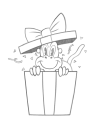Check out the premium course for additional lessons, demos, assignments and critiques!
The Blob Approach
The blob approach helps you capture form quickly by guessing line angles without focusing on proportions. Start with something, decide its position, wrap a rubber band to point it away or toward you, choose a corner that counter-angles the band, snap the curved band into two straight lines, and draw the echoing lines. It's a shortcut to drawing form, moving from rough to refined by guessing lines. If you haven't tried this yet, rehearse it until it feels easy.
Introducing Grids
Now, let's explore a different method: using grids. Grids help you start with accurate lines and compare orthographic views (orthos) to foreshortened views, allowing you to guess proportions.
The Good and Bad of Grids
Grids make invisible lines visible, establishing space in your picture. They act as guidelines or scaffolds, reminding you of turns and directions. However, some artists see grids as shackles that dictate where to go, limiting creativity. Remember, artists create grids, not the other way around. Grids are tools to help you when you want to go somewhere specific in your art.
Learning from Kim Jung Gi
Artist Kim Jung Gi could fill walls with drawings at high speed without any references. His secrets? Knowing his subject's proportions and fitting them into simple structures. These structures give you clues about how much you can dare to foreshorten.
Understanding Foreshortening
Foreshortening makes things appear shorter. In an ortho, a line is at its longest. As it moves away or towards you, it shortens. It can even turn into a dot. In oblique views, lines or planes will foreshorten more or less. Practice drawing foreshortened views to gain confidence.
Tips for Practice
- Guess proportions instead of measuring.
- Focus on foreshortened planes and forms, ignoring details.
- Look along each axis and ask how much it foreshortens.
- Keep it loose and start with multiple drawings.
- Have fun with deliberate distortions if you like.
Embracing Grids and Foreshortening
Use grids as a safety net for line directions. They help you keep track of angles while you work on proportions. As you practice, you'll sharpen your perception and improve your guessing. Whether you see grids as shackles or scaffolds, embracing them can help you emerge as an unshackled artist.
Check out the premium course for additional lessons, demos, assignments and critiques!




